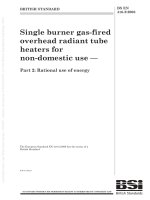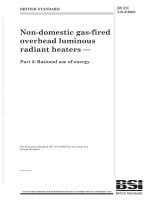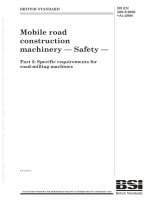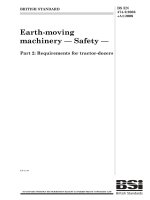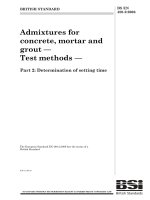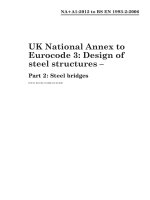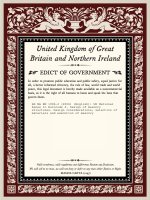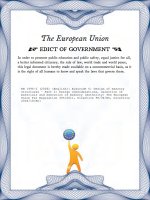Bsi bs en 62040 2 2006 (2012)
Bạn đang xem bản rút gọn của tài liệu. Xem và tải ngay bản đầy đủ của tài liệu tại đây (890.36 KB, 46 trang )
BRITISH STANDARD
BS EN
62040-2:2006
Incorporating
corrigenda
November 2006 and
November 2011
Uninterruptible power
systems (UPS) —
Part 2: Electromagnetic compatibility
(EMC) requirements
ICS 29.200; 33.100.01
BS EN 62040-2:2006
National foreword
This British Standard is the UK implementation of EN 62040-2:2006,
incorporating corrigendum November 2006. It is identical to IEC
62040-2:2005, incorporating corrigendum November 2011. It supersedes BS EN 50091-2:1996 which is withdrawn.
The UK participation in its preparation was entrusted to Technical
Committee PEL/22, Power electronics.
A list of organizations represented on this committee can be obtained on
request to its secretary.
This publication does not purport to include all the necessary provisions
of a contract. Users are responsible for its correct application.
Compliance with a British Standard cannot confer immunity from
legal obligations.
Amendments/corrigenda issued since publication
This British Standard was
published under the authority
of the Standards Policy and
Strategy Committee
on 31 March 2006
© The British Standards Institution 2012. Published by
BSI Standards Limited 2012.
ISBN 978 0 580 76761 6
Amd. No.
Date
Comments
16838
31 January 2007
This corrigendum renumbers BS ISO
24340:2006 as BS EN 24340:2012
30 April 2012
Implementation of IEC corrigendum
November 2011: content replaced in
clause 7.5
Corrigendum No. 1
EN 62040-2
EUROPEAN STANDARD
NORME EUROPÉENNE
EUROPÄISCHE NORM
March 2006
ICS 17.220; 29.200
Supersedes EN 50091-2:1995
Incorporating corrigendum November 2006
English version
Uninterruptible power systems (UPS)
Part 2: Electromagnetic compatibility (EMC) requirements
(IEC 62040-2:2005)
Alimentations sans interruption (ASI)
Partie 2: Exigences pour la compatibilité
électromagnétique (CEM)
(CEI 62040-2:2005)
Unterbrechungsfreie
Stromversorgungssysteme (USV)
Teil 2: Anforderungen an die
elektromagnetische Verträglichkeit (EMV)
(IEC 62040-2:2005)
This European Standard was approved by CENELEC on 2005-10-01. CENELEC members are bound to comply
with the CEN/CENELEC Internal Regulations which stipulate the conditions for giving this European Standard
the status of a national standard without any alteration.
Up-to-date lists and bibliographical references concerning such national standards may be obtained on
application to the Central Secretariat or to any CENELEC member.
This European Standard exists in three official versions (English, French, German). A version in any other
language made by translation under the responsibility of a CENELEC member into its own language and notified
to the Central Secretariat has the same status as the official versions.
CENELEC members are the national electrotechnical committees of Austria, Belgium, Cyprus, the Czech
Republic, Denmark, Estonia, Finland, France, Germany, Greece, Hungary, Iceland, Ireland, Italy, Latvia,
Lithuania, Luxembourg, Malta, the Netherlands, Norway, Poland, Portugal, Romania, Slovakia, Slovenia, Spain,
Sweden, Switzerland and the United Kingdom.
CENELEC
European Committee for Electrotechnical Standardization
Comité Européen de Normalisation Electrotechnique
Europäisches Komitee für Elektrotechnische Normung
Central Secretariat: rue de Stassart 35, B - 1050 Brussels
© 2006 CENELEC -
All rights of exploitation in any form and by any means reserved worldwide for CENELEC members.
Ref. No. EN 62040-2:2006 E
BS EN 62040-2:2006
EN 62040-2:2006 (E)
–2–
Foreword
The text of document 22H/74A/FDIS, future edition 2 of IEC 62040-2, prepared by SC 22H,
Uninterruptible Power Systems (UPS), of IEC TC 22, Power electronic systems and equipment, was
submitted to the IEC-CENELEC parallel vote and was approved by CENELEC as EN 62040-2 on
2005-10-01.
This European Standard supersedes EN 50091-2:1995 + corrigendum January 1998.
The following dates were fixed:
– latest date by which the EN has to be implemented
at national level by publication of an identical
national standard or by endorsement
(dop)
2006-10-01
– latest date by which the national standards conflicting
with the EN have to be withdrawn
(dow)
2008-10-01
This European Standard was prepared under a mandate given to CENELEC by the European
Commission and the European Free Trade Association and supports the essential requirements of
Directive 89/336/EEC (see Annex ZZ).
Annexes ZA and ZZ have been added by CENELEC.
__________
Endorsement notice
The text of the International Standard IEC 62040-2:2005 was approved by CENELEC as a European
Standard without any modification.
__________
–3–
BS EN 62040-2:2006
EN 62040-2:2006 (E)
CONTENTS
1
Scope ............................................................................................................................6
2
Normative references .....................................................................................................7
3
Terms and definitions .....................................................................................................8
4
3.1 8
3.2 8
Environment ...................................................................................................................8
5
UPS Categories..............................................................................................................8
6
5.1 UPS of category C1 ...............................................................................................8
5.2 UPS of category C2 ...............................................................................................9
5.3 UPS of category C3 ...............................................................................................9
5.4 UPS of category C4 ...............................................................................................9
5.5 Categories and environment ..................................................................................9
Emission ......................................................................................................................10
7
6.1 General ...............................................................................................................10
6.2 General requirements ..........................................................................................10
6.3 General measurement conditions.........................................................................10
6.4 Conducted emissions ..........................................................................................11
6.5 Radiated emissions .............................................................................................13
Immunity ......................................................................................................................14
7.1
7.2
7.3
7.4
7.5
7.6
Annex A
General ...............................................................................................................14
General requirements and performance criteria....................................................14
Basic immunity requirements – High-frequency disturbances ...............................15
Immunity to low-frequency signals .......................................................................17
Immunity to power-frequency magnetic field.........................................................17
Immunity to voltage dips, short interruptions and voltage variations......................17
(normative) Electromagnetic emission – Test methods ........................................18
A.1 General ...............................................................................................................18
A.2 Measuring equipment ..........................................................................................18
A.3 Test unit configuration .........................................................................................19
A.4 Determination of maximum emission configuration(s) ...........................................20
A.5 Operation of the equipment under test .................................................................21
A.6 Method of measurement of mains terminal interference voltage............................21
A.7 Method of measurement at a.c. output ports (where applicable) ...........................23
A.8 Method of measurement of radiated emission ......................................................23
A.9 Measurement site ................................................................................................24
A.10 Equipment set-up for radiated emission tests .......................................................24
A.11 Measurement of radiated magnetic disturbances..................................................25
Annex B (informative) Electromagnetic emission limits and measurement methods of
magnetic field – H field .................................................................................................33
Annex C (informative) Electromagnetic emission – Limits of signal ports ...........................35
Annex D (normative) Electromagnetic immunity – Test methods ........................................36
D.1General...................................................................................................................36
D.2Electrostatic discharge (ESD)..................................................................................36
D.3Immunity to radiated electromagnetic (EM) fields .....................................................36
D.6Immunity to low-frequency signals ...........................................................................37
Annex E (informative) User installation testing ...................................................................39
BS EN 62040-2:2006
EN 62040-2:2006 (E)
–4–
Annex ZA (normative) Normative references to international publications with their
corresponding European publications.................................................................40
Annex ZZ (informative) Coverage of Essential Requirements of EC Directives .....................42
Figure 1 – Examples of ports ................................................................................................8
Figure A.1 – Circuit for disturbance voltage measurements on mains supply or UPS
output.................................................................................................................................26
Figure A.2 – Minimum alternative test site ...........................................................................26
Figure A.3 – Set-up for measurement of conducted emission for table-top units...................27
Figure A.4 – Test set-up for floor-standing units ..................................................................27
Figure A.5 – Test configuration for table-top equipment (conducted emission
measurement) ....................................................................................................................28
Figure A.6 – Test configuration for table-top equipment (conducted emission
measurement) – Plan view ..................................................................................................29
Figure A.7 – Alternative test configuration for table-top equipment (conducted
emission measurement) – Plan view ...................................................................................29
–5–
BS EN 62040-2:2006
EN 62040-2:2006 (E)
Figure A.8 – Test configuration for floor-standing equipment (conducted emission
measurement) ....................................................................................................................30
Figure A.9 – Test configuration for table-top equipment (radiated emission
requirement) .......................................................................................................................31
Figure A.10 – Test configuration for floor-standing equipment (radiated emission
measurement) ....................................................................................................................32
Figure B.1 – Test set-up for measuring radiated disturbances .............................................33
Figure D.2 – Phase unbalance ............................................................................................38
Table 1 – Limits of mains terminal interference voltage frequency range 0,15 MHz to
30 MHz for category C1 UPS and category C2 UPS equipment ...........................................12
Table 2 – Limits of mains terminal interference voltage frequency range 0,15 MHz to
30 MHz for Category C3 UPS equipment.............................................................................12
Table 3 – Limits of radiated emission in the frequency range 30 MHz to 1 000 MHz .............13
Table 4 – Performance criteria for immunity tests ................................................................14
Table 5 – Minimum immunity requirements for UPS intended for UPS of category C1 ..........15
Table 6 – Minimum immunity requirements for UPS of category C2 and C3 ........................16
Table B.1 – UPS which has a rated output current less than, or equal to, 16 A ....................34
Table B.2 – UPS which has a rated output current greater than 16A ....................................34
Table C.1 – Limits of signal ports ........................................................................................35
BS EN 62040-2:2006
EN 62040-2:2006 (E)
–6–
UNINTERRUPTIBLE POWER SYSTEMS (UPS) –
Part 2: Electromagnetic compatibility (EMC) requirements
1
Scope
This part of IEC 62040 applies to UPS units intended to be installed
–
as a unit or in UPS systems comprising a number of interconnected UPS and associated
control/switchgear forming a single power system; and
–
in any operator accessible area or in separated electrical locations, connected to lowvoltage supply networks for either industrial or residential, commercial and light industrial
environments.
This part of IEC 62040 is intended as a product standard allowing the EMC conformity
assessment of products of categories C1, C2 and C3 as defined in this part of IEC 62040,
before placing them on the market.
Equipment of category 4 is treated as a fixed installation. Checking is generally done after
installation in its final place of use. Sometimes partial checking may be done before. See
Annex E
The requirements have been selected so as to ensure an adequate level of electromagnetic
compatibility (EMC) for UPS at public and industrial locations. These levels cannot, however,
cover extreme cases, which may occur in any location but with extremely low probability of
occurrence.
This part of IEC 62040 takes into account the differing test conditions necessary to
encompass the range of physical sizes and power ratings of UPS.
A UPS unit or system shall meet the relevant requirements of this part of IEC 62040 as a
stand-alone product. EMC phenomena produced by any customers' load connected to the
output of the UPS equipment shall not be taken into account.
Special installation environments are not covered, nor are fault conditions of UPS taken into
account.
This part of IEC 62040 does not cover d.c. supplied electronic ballast or UPS based on
rotating machines.
This part of IEC 62040 states:
–
EMC requirements;
–
test methods;
–
minimum performance levels.
BS EN 62040-2:2006
EN 62040-2:2006 (E)
–7–
2
Normative references
The following referenced documents are indispensable for the application of this document.
For dated references, only the edition cited applies. For undated references, the latest edition
of the referenced document (including any amendments) applies.
IEC 60050-161:1990, International
Electromagnetic compatibility
Electrotechnical
Vocabulary
(IEV) – Chapter 161:
IEC 61000-2-2:2002, Electromagnetic compatibility (EMC) – Part 2-2: Environment –
Compatibility levels for low-frequency conducted disturbances and signalling in public lowvoltage power supply systems
IEC 61000-3-2:2000, Electromagnetic compatibility (EMC) – Part 3-2: Limits – Limits for
harmonic current emissions (equipment input current – 16 A per phase)
IEC 61000-4-1:2000, Electromagnetic compatibility (EMC) – Part 4-1: Testing and measurement techniques – Overview of IEC 61000-4 series
IEC 61000-4-2:1995, Electromagnetic compatibility (EMC) –
measurement techniques – Electrostatic discharge immunity test
Part
4-2:
Testing
and
IEC 61000-4-3:2002, Electromagnetic compatibility (EMC) – Part 4-3: Testing and measurement techniques – Radiated, radio-frequency, electromagnetic field immunity test
IEC 61000-4-4:2004, Electromagnetic compatibility (EMC) – Part
measurement techniques – Electrical fast transient/burst immunity test
4-4:
Testing
and
IEC 61000-4-5:1995, Electromagnetic compatibility (EMC) – Part 4-5: Testing and measurement techniques – Surge immunity test
IEC 61000-4-6:2003, Electromagnetic compatibility (EMC) – Part 4-6: Testing and measurement techniques – Immunity to conducted disturbances induced by radio-frequency fields
IEC 61000-4-8:1993, Electromagnetic compatibility (EMC) – Part 4-8: Testing and measurement techniques – Power frequency magnetic field immunity test
IEC 62040-3:1999, Uninterruptible power systems (UPS) – Part 3: Method of specifying the
performance and test requirements
CISPR 16-1-1:2003, Specification for radio disturbance and immunity measuring apparatus
and methods – Part 1-1: Radio disturbance and immunity measuring apparatus – Measuring
apparatus
CISPR 16-1-2:2003, Specification for radio disturbance and immunity measuring apparatus
and methods – Part 1-2: Radio disturbance and immunity measuring apparatus – Ancillary
equipment – Conducted disturbances
CISPR 22:2005, Information technology equipment – Radio disturbance characteristics –
Limits and methods of measurement
BS EN 62040-2:2006
EN 62040-2:2006 (E)
3
–8–
Terms and definitions
For the purposes of this document, the terms and definitions given in IEC 60050-161 related
to EMC and to relevant phenomena apply, together with the following.
3.1
port
particular interface of the UPS with the external electromagnetic environment (see Figure 1)
3.2
enclosure port
physical boundary of the UPS through which electromagnetic fields may radiate or impinge
AC input power port
Enclosure port
AC output power port
UPS
Signal/control port
Earth port
DC power port (battery)
IEC 1655/05
Figure 1 – Examples of ports
4
Environment
The following examples of environment cover the majority of UPS installations.
a) First environment: environment that includes residential, commercial and light industrial
premises directly connected without intermediate transformers to a public low-voltage
mains supply.
b) Second environment: environment that includes all commercial, light industry and
industrial establishments other than those directly connected to a low-voltage mains that
supplies buildings used for residential purposes.
5
5.1
UPS Categories
UPS of category C1
This category includes UPS intended for use without any restriction in the first environment.
Such UPS are suitable for use in residential establishments.
Category C1 UPS shall meet the category C1 UPS emission limits and withstand the
immunity requirements of Table 5.
–9–
5.2
BS EN 62040-2:2006
EN 62040-2:2006 (E)
UPS of category C2
This category includes UPS with an output current not exceeding 16 A and intended for use
without any restriction in the second environment. Such UPS may also be used in the first
environment when connected:
–
through industrial plugs and sockets or
–
through national plugs and sockets or
–
permanently.
Category C2 UPS shall meet the category C2 UPS emission limits and withstand the
immunity requirements of Table 6.
The following wording shall be included in the instructions for use.
WARNING: This is a category C2 UPS product. In a residential environment, this product
may cause radio interference, in which case the user may be required to take additional
measures.
5.3
UPS of category C3
This category includes UPS with an output current exceeding 16 A and intended for use in
the second environment. Such UPS are suitable for use in commercial or industrial
installations having a minimum boundary of 30 m from other buildings classified as first
environment.
Category C3 UPS shall meet category C3- UPS emission limits and withstand the immunity
requirements of Table 6.
The following wording shall be included in the instructions for use.
WARNING: This is a product for commercial and industrial application in the second
environment
installation restrictions or additional measures may be needed to prevent
disturbances.
5.4
UPS of category C4
This category includes UPS intended for use in complex environments and subject to an
agreement between supplier and customer regarding applicable emission and immunity
levels.
The UPS of category C4 is not limited by current ratings.
5.5
Categories and environment
If the environment has been determined as the first environment, UPS of category C1 or C2
should be used.
If the environment has been determined as the second environment, UPS of category C2 or
C3 should be used.
If the environment is not covered exclusively either by the first or second environment, UPS
of category C4 should be used.
BS EN 62040-2:2006
EN 62040-2:2006 (E)
6
– 10 –
Emission
6.1
General
Disturbances in the frequency range from 0 Hz to 1,0 GHz are covered.
The emission requirements have been selected so as to ensure that disturbances generated
by UPS operating normally do not reach a level which could prevent other apparatus from
operating as intended.
NOTE 1 The limits in this part of IEC 62040 may not, however, fully provide protection against interference to
radio and television reception when the UPS is used closer than 10 m to the receiving antenna for category C1 or
C2 UPS and 30 m for category C3 UPS.
NOTE 2 In special cases, for instance, when highly susceptible apparatus is being used in proximity, additional
mitigation measures may have to be employed to reduce the electromagnetic emission further below the specified
levels.
6.2
General requirements
UPS shall comply with the emission limits of 5.3 to 5.4.
The tests shall be made with the UPS in the following conditions:
–
rated input voltage;
–
normal and stored energy mode of operation;
–
linear load that results in the highest interference level.
The objective of 5.4 is to define limits and test methods for UPS defined in the scope of this
part of IEC 62040 in relation to electromagnetic emissions which may cause interference in
other apparatus, for example, radio receivers.
These emission limits represent essential electromagnetic compatibility requirements.
Test requirements are specified for each port considered. Refer to Annex A for test
methodology.
6.3
6.3.1
General measurement conditions
General
The measurements shall be made in the operating mode producing the largest emission in
the frequency band being investigated consistent with normal applications. UPS operating
modes (normal mode and stored energy mode) shall be investigated.
An attempt should be made to maximise the emission by varying the test set-up configuration
of the test sample.
– 11 –
BS EN 62040-2:2006
EN 62040-2:2006 (E)
For UPS with additional mains terminals (ports) for the connection of separate supplies for
static by-pass and/or maintenance by-pass circuits, these terminals (ports) shall, wherever
possible, be temporarily connected to the normal a.c. input port supply. Conducted emission
tests in 5.3 shall include measurement of these additional circuits.
If the UPS is part of a system or can be connected to auxiliary accessories, then the UPS
shall be tested while connected to the minimum configuration of auxiliary accessories
necessary to exercise the ports, or be terminated in an equivalent impedance.
UPS a.c. outputs shall be loaded with a linear load capable of operating the unit under test
for any load condition within its output rating.
The configuration and mode of operation during measurement shall be precisely noted in the
test report. Refer to Annex A for test set-up and measurement criteria. For in situ testing,
see Annex E. The tests shall be carried out within the specific operating environment range
for the UPS and at its rated supply voltage, unless otherwise indicated.
6.3.2
Documentation for the purchaser/user
a) The purchaser/user shall be informed if special measures have to be taken to achieve
compliance, for example, the use of shielded or special cables. Any restriction on the
length of the a.c. output cables shall also be indicated.
b) Notwithstanding that the scope of supply of the UPS shall comply with any local
regulation, documentation shall be available to the purchaser/user upon request. A list of
auxiliary accessories, together with the UPS complying with the emission requirements,
shall be made available.
6.3.3
Applicability
Measurements are made on the relevant ports of the UPS.
6.4
6.4.1
Conducted emissions
Limits of mains terminal interference voltage
The UPS shall not exceed the limits of either Tables 1 or 2 according to the category of UPS
and the rated output current under test.
The UPS shall meet both the average and quasi-peak limit when using, respectively, an
average detector receiver and a quasi-peak detector receiver, and measured in accordance
with the methods described in Clause A.6.
If the average limit is met when using a quasi-peak detector receiver, the test unit shall be
deemed to meet both limits, and measurement with the average detector receiver is unnecessary.
If the reading on the measuring receiver shows fluctuations close to the limit, the reading
shall be observed for at least 15 s at each measurement frequency; the highest reading shall
be recorded, with the exception of any brief isolated high reading, which shall be ignored.
BS EN 62040-2:2006
EN 62040-2:2006 (E)
– 12 –
a) UPS of category C1 and C2
Table 1 – Limits of mains terminal interference voltage frequency range
0,15 MHz to 30 MHz for category C1 UPS and category C2 UPS equipment
Frequency
range
Limits
dB(μV)
MHz
Category C1 UPS
Quasi-peak
0,15 to 0,50
0,50 to 5
66 to 56
b
5 to 30
Category C2 UPS
Average
a
56 to 46
Quasi-peak
Average
79
66
a
56
46
73
60
60
50
73
60
a
The limit decreases linearly with the logarithm of the frequency.
b
The lower limit shall apply at the transition frequency.
b) UPS of category C3
Table 2 – Limits of mains terminal interference voltage frequency range
0,15 MHz to 30 MHz for Category C3 UPS equipment
UPS rated output current
Frequency range
A
MHz
0,15 to 0,50
>16 – 100
0,50 to 5,0
Limits
dB (μV)
Quasi-peak
Average
100
90
b
b
5,0 to 30,0
0,15 to 0,50
>100
0,50 to 5,0
90 to 70
b
b
5,0 to 30,0
a
The limits decrease linearly with the logarithm of the frequency.
b
The lower limit shall apply at the transition frequency.
6.4.2
86
76
a
80 to 60
130
120
125
115
115
105
a
Limits of a.c. output interference voltage
The limits in Tables 1 and 2 apply.
An allowance of +14 dB is permitted for conducted disturbances at the output of the UPS as
specified in Tables 1 and 2, except for C3 greater that 100 A where no increase is allowed.
These limits only apply to UPS where the output cable, as declared by the manufacturer, in
his users’ instructions, can exceed 10 m in length.
The values shall be measured using a voltage probe in accordance with A.2.3.
6.4.3
Limits of signal and telecommunication ports
For ports intended for connection to the public switched telecommunication network (PSTN),
the test methods and limits of CISPR 22 apply (see also Annex C).
BS EN 62040-2:2006
EN 62040-2:2006 (E)
– 13 –
6.4.4
Limits of d.c. ports
The d.c. port is deemed an internal part of the UPS and, as such, is not subject to limits of
conducted interference. The effect of conducted interference on the d.c. port may, however,
cause radiated interference, but no further tests are required, provided that the UPS, in both
normal and in stored energy modes of operation and when set-up as described in this clause,
complies with the radiated requirements according to 6.5.55.
Where a UPS is provided with terminals for the connection of an external d.c. source, this
port shall be included in the test set-up and tested as shown below.
For table-top UPS, the battery and its enclosure shall be installed in a position permitted by
the manufacturer's instructions. For floor-standing UPS, the external d.c. source and its
enclosure shall be positioned 0,8 m from the UPS and wired in accordance with the
manufacturer's instructions. For large UPS, where the d.c. source will be installed at a
distance from the UPS, the port shall be wired in accordance with the manufacturer's
instructions, and a test battery or power supply shall be fitted to the d.c. source end of the
cables to enable measurement in stored energy mode.
6.4.5
Low-frequency emissions – Input current harmonics
If the rated input current and voltage are within the scope of IEC 61000-3-2, the limits and
test methodology therein shall apply.
6.5
Radiated emissions
6.5.1
Electromagnetic field
The UPS shall meet the limits of Table 3. If the reading on the measuring receiver shows
fluctuations close to the limit, the reading shall be observed for at least 15 s at each
measurement frequency; the highest reading shall be recorded, with the exception of any
brief isolated high reading, which shall be ignored.
No limits apply for radiated emission below 30 MHz.
Measurements methods and informative limits for study are given in Annex B.
Table 3 – Limits of radiated emission in the frequency range 30 MHz to 1 000 MHz
Frequency range
Quasi-peak limits
dB(μV/m)
MHz
Category C1 UPS
Category C2 UPS
Category C3 UPS
30 to 230
30
40
50
230 to 1 000
37
47
60
The lower limit shall apply at the transition frequency.
NOTE 1 The test distance is 10 m. If the emission measurement at 10 m cannot be made because of high
ambient noise levels or for other reasons, measurement may be made at a closer distance, for example, 3 m (see
CISPR 22, 10.3.1, note).
NOTE 2
Additional provisions may be required for cases where interference occurs.
BS EN 62040-2:2006
EN 62040-2:2006 (E)
6.5.2
– 14 –
Magnetic field
No limits apply for magnetic emissions. Refer to Annex B for measurement methods and
informative limits.
7
7.1
Immunity
General
Immunity requirements in the frequency range 0 Hz to 1 GHz only are covered.
These test requirements represent essential electromagnetic compatibility immunity requirements. Test requirements are specified for each port considered.
The levels given in this clause do not cover extreme cases, which may occur in any location
but with an extremely low probability of occurrence. For such cases, higher levels may be
required.
NOTE In special cases, situations will arise where the level of disturbances may exceed the levels specified in
this part of IEC 62040, for example, where a hand-held transmitter is used in proximity of a UPS. In these
instances, special mitigation measures may have to be employed.
7.2
General requirements and performance criteria
The equipment shall, as a minimum, comply with the immunity limits of 7.3 to 7.6. The
performance criteria adequate for UPS are given in Table 4.
Table 4 – Performance criteria for immunity tests
Criterion A
Criterion B
Output characteristics
Voltage permitted to vary only within
the steady-state characteristics
applicable ( 100 m sec limits in
Figures 1, 2 or 3 of IEC 62040-3)
Voltage permitted to vary within the
inverse time characteristics applicable
(<100 m sec limits in Figures 1, 2 or 3 of
IEC 62040-3)
External and internal
indications and metering
Change only during test
Change only during test
Control signals to external
devices
No change
Change only temporarily in consistency
with the actual UPS mode of operation
Mode of operation
No change
Change only temporarily
The tests shall be made with the UPS in the following conditions:
–
rated input voltage;
–
normal mode of operation;
–
linear load at rated active output power or at light load according to IEC 62040-3.
The UPS shall be specified with the proper level in case of different levels of performance
criteria.
Refer to Annex D for test methodology.
BS EN 62040-2:2006
EN 62040-2:2006 (E)
– 15 –
7.3
Basic immunity requirements – High-frequency disturbances
7.3.1
Conditions
In Tables 5 and 6, the minimum immunity requirements for high-frequency disturbance tests,
and acceptance criteria are stated. The acceptance criteria are detailed in Table 4.
7.3.2
Equipment of category C1
The levels in Table 5 shall be applied to UPS of category C1. If a UPS is designed to have
immunity according to Table 5, it shall include a written warning in the catalogue or on the
equipment which indicates that it is not intended to be used in an industrial environment.
Table 5 – Minimum immunity requirements for UPS intended for UPS of category C1
Port
Phenomenon
Basic standard
for test method
Performance
(acceptance)
criterion
Level
4 kV CD
ESD
IEC 61000-4-2
IEC 61000-4-3
Fast transient-burst
IEC 61000-4-4
3 V/m
A
80 % AM (1 kHz)
1 kV/5 kHz
a
B
b
1,2/50 us,
IEC 61000-4-5
8/20 us
common mode
1 kV
c
2 kV
d
B
0,15 to 80 MHz
Conducted radiofrequency
Signal and control
ports
80 to 1 000 MHz
Radio-frequency electromagnetic field, amplitude
modulated.
Surge
DC power port
B
if CD impossible
Enclosure port
AC input and output
power ports
or 8 kV AD
IEC 61000-4-6
e
3V
A
80 % AM (1 kHz)
Fast transient-burst
e
Fast transient-burst
e
IEC 61000-4-4
IEC 61000-4-4
1 kV/5 kHz
Capacitive clamp
1 kV/5 kHz
Capacitive clamp
B
B
0,15 to 80 MHz
Conducted radioe
frequency common mode
IEC 61000-4-6
3V
A
80 % AM (1 kHz)
CD = contact discharge AD = air discharge AM = amplitude modulation
a
Power ports with current rating < 100 A: direct coupling using the coupling and decoupling network. Power
ports with current rating > 100 A: direct coupling or capacitive clamp without decoupling network. If the
capacitive clamp is used, the test level shall be 2 kV/5 kHz.
b
Light-load test condition is acceptable for power ports rated for current > 63A.
c
Coupling line to line.
d
Coupling line to earth.
e
Applicable only to ports or interfaces with cables whose total length according to the manufacturer's functional
specification may exceed 3 m.
BS EN 62040-2:2006
EN 62040-2:2006 (E)
7.3.3
– 16 –
Equipment of category C2 and C3
The levels in Table 6 shall be applied to UPS, which are intended to be used in the second
environment.
Table 6 – Minimum immunity requirements for UPS
of category C2 and C3
Port
Enclosure port
Phenomenon
ESD
IEC 61000-4-2
Radio-frequency
electromagnetic
field, amplitude
modulated
IEC 61000-4-3
Fast transientburst
IEC 61000-4-4
Surge
AC input and output power
ports
DC power port
Performance
(acceptance)
criterion
Level
4 kV CD
B
or 8 kV AD
80 to 1 000 MHz
10 V/m
A
80 % AM (1 kHz)
b
1,2/50 us, 8/20 us
IEC 61000-4-5
2 kV/5 kHz
1 kV
c
2 kV
d
a
B
B
0,15 to 80 MHz
Conducted radiofrequency
e
common mode
IEC 61000-4-6
Fast transiente
burst
IEC 61000-4-4
Fast transiente
burst
IEC 61000-4-4
Surge
Signal and control ports
Basic standard for
test method
10 V
A
80 % AM (1 kHz)
2 kV/5 kHz
Capacitive clamp
2 kV/5 kHz
Capacitive clamp
B
B
f
1,2/50 us, 8/20 us
Conducted radiofrequency
e
common mode
IEC 61000-4-5
1 kV
(e) (f)
,
B
0,15 to 80 MHz
IEC 61000-4-6
10 V
A
80 % AM (1 kHz)
CD = contact discharge AD = air discharge AM = amplitude modulation
a
Power ports with current rating <100 A: direct coupling using the coupling and decoupling network. Power ports
with current rating >100 A: direct coupling or capacitive clamp without decoupling network. If the capacitive
clamp is used, test level shall be 4 kV/5 kHz.
b
Light-load test condition is applicable for power ports rated for current > 63 A.
c
Coupling line to line.
d
Coupling line to earth.
e
Applicable only to ports or interfaces with cables whose total length according to the manufacturer's functional
specification may exceed 3 m.
f
Applicable only to ports with cables whose total length according to the manufacturer's functional specification
may exceed 30 m. In the case of shielded cable, a direct coupling to the shield is applied. This immunity
requirement does not apply to fieldbus or other signal interfaces where the use of surge protection devices is
not practical for technical reasons. The test is not required where normal functioning cannot be achieved
because of the impact of the coupling/decoupling network on the equipment under test (EUT).
– 17 –
7.4
BS EN 62040-2:2006
EN 62040-2:2006 (E)
Immunity to low-frequency signals
The UPS in operation shall withstand the low-frequency conducted disturbances and
signalling in the mains for mains compatibility as specified in IEC 61000-2-2 and as detailed
in Annex D (see Clause D.6).
Compliance is checked by simulating the above conditions, and the UPS shall continue to
operate without degradation of the specified performances. Criterion: A.
7.5
Immunity to power-frequency magnetic field
The UPS in operation shall withstand disturbances induced by power-frequency magnetic
fields as specified in IEC 61000-4-8: level 2 (3 A/m) for category C1; level 4 (30 A/m) for
category C2 and C3.
Compliance is checked by simulating the above conditions, The UPS shall continue to
operate without degradation of the specified performances. Criterion: B.
7.6
Immunity to voltage dips, short interruptions and voltage variations
This feature relates to one of the main objectives of a UPS as specified in IEC 62040-3.
BS EN 62040-2:2006
EN 62040-2:2006 (E)
– 18 –
Annex A
(normative)
Electromagnetic emission –
Test methods
A.1
General
The purpose of these tests is to measure the levels of electromagnetic emission produced by
the UPS and propagated by conduction and radiation.
This Annex mainly concerns continuous electromagnetic emissions.
Due to the range of physical size and power ratings, the manufacturer may choose the most
appropriate test site and configuration that is best to physically accommodate the UPS.
In some cases, for example, for multi-module systems, the only solution will be a siteinstalled evaluation. Therefore, the following test set-ups and methods provide, as far as
possible, the general criteria to cater for most UPS.
A.2
A.2.1
Measuring equipment
Measuring instruments
Receivers with quasi-peak detectors and with average detectors shall be in accordance with
CISPR 16 series of standards.
NOTE Measuring instruments having other detector characteristics may be used provided the measurement of
the disturbance values can be proved to be the same. Attention is drawn to the convenience of using a panoramic
receiver or a spectrum analyser, particularly if the working frequency of the equipment under test changes
appreciably during the work cycle.
A.2.2
Artificial mains network (AMN)
Measurement of the mains terminal disturbance voltage shall be made using an artificial
mains network consisting of 50 :/50 μH network as specified in section 4 of CISPR 16-1-2.
The artificial network is required to provide a defined impedance at radiofrequency across the
mains supply at the point of measurement and also to provide for isolation of the equipment
under test from ambient noise on the power lines.
A.2.3
Voltage probe
The voltage probe, in accordance with the requirements of Clause 12 of CISPR 16-1-2, and
shown in Figure A.1 shall be used where specified for UPS outputs, and when the artificial
mains network cannot be used due to the current rating of the input of the UPS. The probe is
connected sequentially between each line and the reference earth chosen (metal plate, metal
tube).
